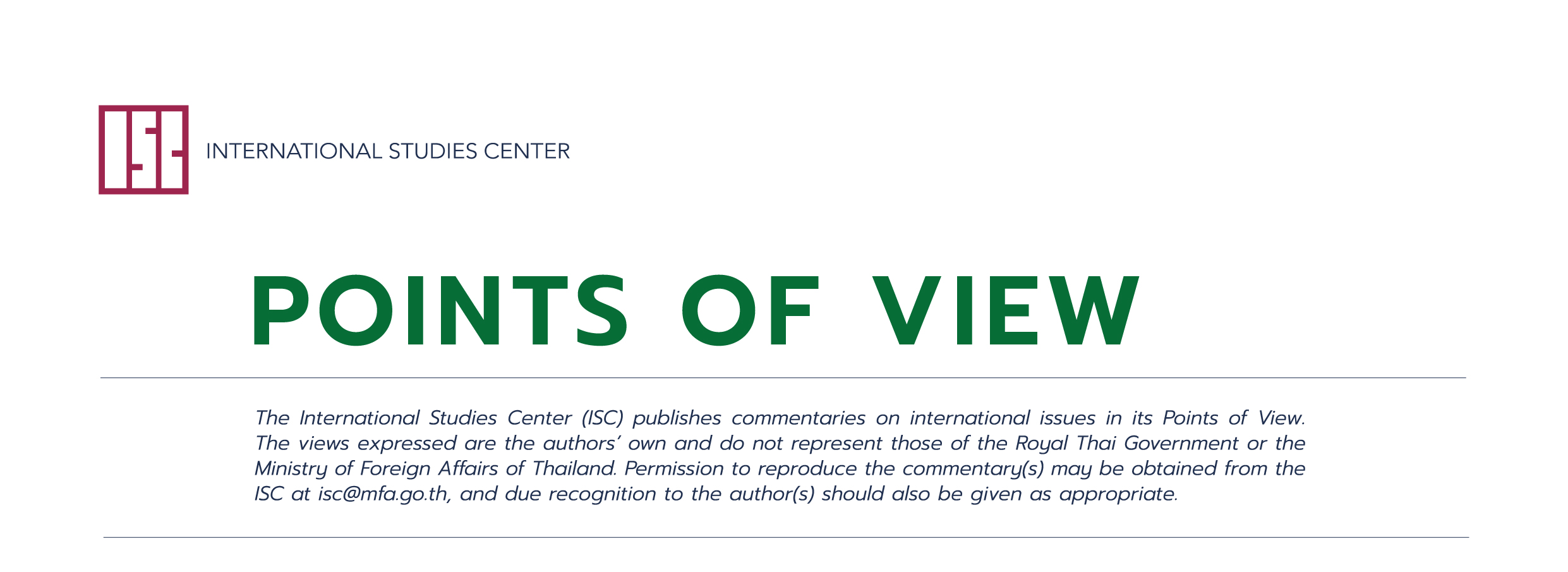ASEAN-India: Rejuvenation and Reconfiguration | Shristi Pukhrem
ASEAN-India: Rejuvenation and Reconfiguration | Shristi Pukhrem
วันที่นำเข้าข้อมูล 29 Jul 2025
วันที่ปรับปรุงข้อมูล 29 Jul 2025

No. 6/2025 | July 2025
ASEAN-India: Rejuvenation and Reconfiguration
Shristi Pukhrem*
(Download .pdf below)
The 58th ASEAN Foreign Ministers’ Meeting (FMM) took place in Kuala Lumpur earlier this month, reiterating the commitment of ASEAN Member States (AMS) to inclusivity and sustainability. The meeting underscored the rising alignment under the ASEAN Vision 2045 framework, and a rejuvenated focus on crafting a ‘resilient, innovative, dynamic and people-centered community’.
The Joint Communique of the 58th ASEAN-FMM highlights ASEAN’s resolve for deeper ties with Dialogue Partners and focus on new Strategic Partnerships. The recent meetings held with key dialogue partners underscored ASEAN’s emphasis on multi-alignment that is gradually enveloping the world.
These meetings are also notable as they emphasised on the rising apprehensions regarding escalating global trade tensions. While unilateral tariffs have been characterised as "counterproductive" , attention has been drawn to the evolving threats of global economic fragmentation. As the U.S.-China duel unfolds, multi-alignment and tightrope-walking are now the requisite features for all around the two. This has led to efforts like Malaysia’s advocacy for increased trade within ASEAN to mitigate external pressures and lessen dependence on extra-regional blocs.
ASEAN also held the Post-Ministerial Conference with India, adopting the new ASEAN-India Plan of Action (2026-2030). The plan will now guide ASEAN–India engagement through to 2030, covering trade, security, connectivity, digital economy, and human development cooperation.
With the new action plan, India's role as a crucial partner to ASEAN has been solidified, consistent with India’s Act East Policy (AEP) and its Indo-Pacific Oceans Initiative (IPOI), both of which strive to forward ASEAN Centrality. Having completed a decade, the AEP has moved beyond a mere policy instrument to engage with East and South-East Asia, and is now an anchor of India’s approach to the Indo-Pacific.
With technology now shaping the new era, India has a chance to shape new partnerships with the AMS and cooperate on infusing innovation and digitalisation. Both sides should strive to take forward programs of joint R&D, technology transfers, and capacity-building programs to drive economic growth and development. A recent welcome move to this end has been the agreement between the central banks of India and the four ASEAN Countries—Malaysia, Singapore, Philippines, and Thailand, to enable the retail cross-border payments.
As comprehensive strategic partners, India and ASEAN continue to strengthen their partnership by rejuvenating the core principles of 3Cs – Commerce, Culture, and Connectivity.
Today, trade and commerce are foundational pillars for any partnership, especially between rising economies. While the India-ASEAN Free Trade Agreement (FTA) inked in 2010 has served as backbone of economic engagement, recent discourse indicating considerations around the asymmetrical nature of the FTA point to rising challenges. This demands acknowledging the need for reconfiguring priorities and fine-tuning the engagement mechanisms.
Meanwhile, the collaboration is being strengthened in other domains. India and ASEAN have committed to establish cruise tourism circuits which will serve as a new corridor of connectivity. This will enhance the India-ASEAN potential and advance maritime, tourism and ports connectivity in the Bay of Bengal and Indian Ocean Region. Recent developments indicate efforts towards establishing ASEAN-India Cruise Tourism Corridor and increasing direct air connectivity between India and AMS.
ASEAN has also recognised the cross-cutting nature of maritime issues and emphasised on an integrated and comprehensive approach to maritime cooperation. As India looks to celebrate the year 2026 as the ‘ASEAN-India Year of Maritime Cooperation’, the increasing convergence in the maritime domain also offers an opportunity for a closer partnership.
What ASEAN is striving for today is a reconfiguration of its priorities and partnerships, focusing on those which deliver results aligned with its strategic interests. It is up to key partners like India to sync their vision with ASEAN’s, laying down frameworks for more robust and deeper regional cooperation.
[*] Dr. Shristi Pukhrem is Deputy Director (Academics & Research) at India Foundation. Her work revolves around India-ASEAN relations, India’s bilateral relations with SEA countries, and India's Act East Policy.